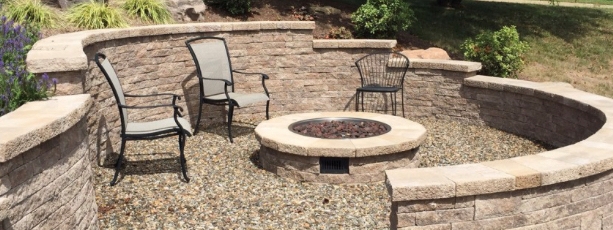
When I was asked to write a series of articles related to outdoor living I immediately said yes. I quickly realized what a broad topic outdoor living is. When penning a series this a good problem to have as the topic allows for a seemingly endless variety of subtopics. I write mostly industry specific articles which are more technical in nature but rarely have the opportunity to write about what I love just for fun.
The initial question was where to start, but more importantly where to start when it is almost winter. I went through some notes from an industry seminar I attended in January of 2018 and found exactly what I needed. The most searched for keyword related to outdoor living.
That keyword is fire pit followed closely by fire feature. The idea of gathering around a fire brings back memories of summer camp, family vacations and good times shared with friends and loved ones. A fire pit is a great way to make outdoor living a year round reality. I love them!
From over 30 years of initial client interviews I can attest to the fact that we receive an incredible amount of interest in fire features. More often than not a fire feature; be it an outdoor fireplace, built in wood burning fire pit or a direct feed natural gas or propane fire feature is a hot commodity (pardon the pun). 95% of the time, from a landscape design/ architecture perspective, I successfully talk people out of committing to a built in feature before they do some simple experiments to determine the best place to set the feature permanently.
The main problems with built in features are their size and permanent stationary nature. For safety reasons the distance a standard wood burning fire feature should be away from the house, surrounding houses, fences or outbuildings such as sheds is absolutely critical and the most important question to answer on your fire feature check list. Local ordinance generally require a minimum of 15’ but a quick phone call to your local firehouse will answer this question definitively.
I have lived through two house fires in my lifetime and can tell you from firsthand experience that there is absolutely nothing more horrible than being displaced from your home and losing treasured family heirlooms, photographs and even things as mundane as your favorite pair of socks. If you don’t have the appropriate fire suppression tools at hand in your home you absolutely need to purchase these immediately.
I always recommend that anyone who is truly interested in a fire pit go to the local hardware store (I am a big proponent of supporting local small businesses) or, if it is more convenient, the big box stores. I have seen portable fire pits for sale at quite a few grocery stores as well which truly speaks to how popular these features are.
These portable features are inexpensive and will be the easiest way to determine the best place to locate a possible built in feature on your property and have fun doing it in the process. I am not exaggerating when I say that I have had hundreds of clients over the years thank me for this bit of advice. So many people love the idea of a fire pit but regret where they placed it on their property.
The other really important thing to remember about a permanent fire feature is its size. Your average fire pit kit is 4’ across. Fire pit kits are made of a decorative stacked block and come in a wide range of colors.
Two popular kits made by Techo-Bloc — the Valencia kit which is round and the Mini Creta kit which is square, are both about 4’ across with an inside hearth that is approximately 2’. From a placement perspective you will want to allow for at least a 3’ foot area for chairs to sit back from the fire feature so that you and your guests don’t get singed. If your average outdoor chair is approximately 2’ deep the math is very simple.
A built-in wood burning fire pit requires an 18’ diameter seating area. If you go this route, regardless of the manufacturer, you will also need to purchase an insert. SRW or segmental retaining wall block is not fire rated. Fire brick is an alternative but since it is mortar set you will need to construct your fire pit on a foundation which is not susceptible to the 70-100 freeze thaw cycles we experience in Maryland every year.
I strongly recommend an insert with a cover so you can keep the interior of the hearth dry when it is not in use. If you go this route I would also recommend getting a tabletop made for your fire feature either out of glass or granite. If you do this you won’t need the cover and your fire pit will double as a standard table making the feature extremely versatile.
Fire pits and fire places can also be outfitted with propane or natural gas feeds. This eliminates the need for wood (just press a button) and since it is far easier to control the size of the fire can allow for the installation of the fire feature you always wanted even if your property is not a good fit for a wood burning feature (i.e townhouse or cluster development).
Fire tables are a great option as well if the wood burning aspect is not that important to you or you are working with a limited amount of space. These offer far more flexibility as they are generally set up very much like a gas grill with a built in compartment for the propane tank. These are basically functional pieces of furniture, are less expensive all said and done than the built in kits and can be used on decks provided that you follow the manufacturer’s instructions.
We have partnered with our plumber on dozens of occasions and run direct feed lines to these eliminating the need to ever bother with the propane tank.
Outdoor fire places, pizza ovens, outdoor kitchens and other specialty features can really make your backyard the place to be year round. I will happily cover these topics in future articles. Always remember when investing in your home it is vitally important that you use the same guidelines you would use for any other investment. Think in terms of sustainability and quality instead of just price.
You wouldn’t transfer your retirement fund to the lowest bidder and hope for the best, would you? In short do your due diligence.
Kevin A. Moore, is an award-winning design, landscape and general construction expert with 30 years of hands-on experience solving complex grading, retaining wall, erosion and storm-water management problems and creating dream outdoor living spaces. A Baltimore native, Kevin has exclusively worked in the mid-Atlantic area. Kevin A. Moore is the Vice President and Chief Operating officer of Carroll Landscaping and CLI Home Services Incorporated.
You can connect with Kevin A. Moore on LinkedIn and Twitter @kevincarrolllan or email him at Kamoorecl@gmail.com. Check out the Carroll Landscaping YouTube channel for more tips.

